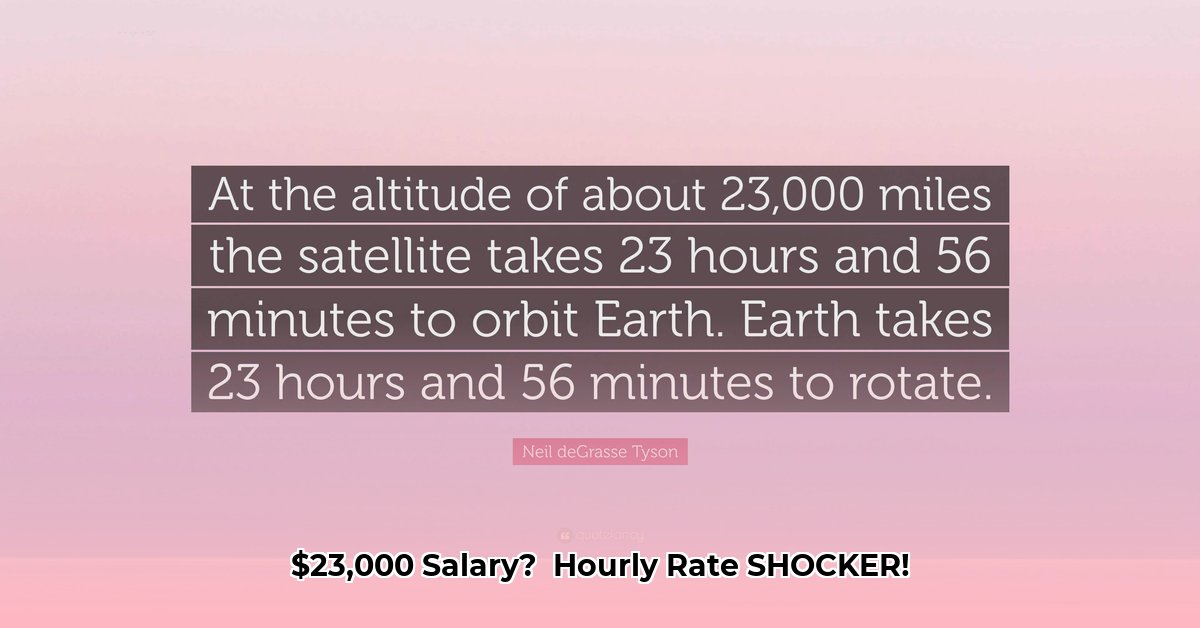
Understanding Your Hourly Rate: More Than Just a Simple Calculation
Converting your annual salary to an hourly rate seems straightforward, but several factors can significantly affect the final figure. This guide provides a clear, step-by-step approach to calculating your hourly rate from a $23,000 annual salary, while also highlighting important nuances often overlooked. Understanding this is crucial for evaluating job offers and budgeting effectively. For more detailed examples, see this helpful salary converter.
The Basic Hourly Rate Calculation
The simplest method for calculating your hourly rate involves dividing your annual salary by the total number of hours worked annually. Let's assume a standard 40-hour workweek and a 50-week work year (accounting for typical vacation and holidays).
Step 1: Calculate annual working hours: 40 hours/week * 50 weeks/year = 2000 hours/year
Step 2: Calculate the hourly rate: $23,000 / 2000 hours = $11.50/hour
This gives a basic hourly rate of approximately $11.50. However, this is just a starting point. Several real-world factors can significantly alter this figure. Do you think this simple calculation accurately reflects your actual earnings?
Real-World Factors Affecting Your Hourly Rate
The basic calculation, while useful, omits several crucial aspects of compensation. Let's examine three key issues.
Paid Time Off (PTO)
Paid time off, including vacation days, sick leave, and holidays, affects your effective hourly rate because, though it is paid time, you are not actively working during these periods. For instance, two weeks of vacation (80 hours) reduce your annual working hours to 1920. This recalculates the hourly rate to approximately $12.00 ($23,000 / 1920 hours). This illustrates how non-working paid hours impact your hourly compensation. What percentage of your year is paid time off in your current situation?
The Value of Employee Benefits
Health insurance, retirement plans (401(k)s), and other employer-provided benefits represent a significant portion of your total compensation. These aren't directly reflected in the hourly rate calculation and can greatly increase the total value of the employment offer. While difficult to assign a precise monetary value to these benefits, their considerable worth should always be factored into your overall compensation assessment. How would you evaluate the monetary benefit of your health insurance plan?
Cost of Living Variations
Your hourly rate's purchasing power varies significantly across different locations. The same hourly rate will afford a different standard of living in a high-cost city versus a lower-cost rural area. Resources like the Bureau of Labor Statistics (https://www.bls.gov/) provide valuable data on regional cost-of-living differences allowing for a more comprehensive comparison of total compensation packages. Does your current income comfortably cover your cost of living?
Utilizing Online Salary Converters
Numerous online salary calculators can assist in converting annual to hourly rates. While helpful for preliminary estimations, these tools rely on assumptions and should be viewed as approximate. Always cross-reference these estimations with official employer documentation (offer letter, employment contract).
Conclusion: A Holistic View of Compensation
The hourly rate calculation provides a basic understanding but should not be viewed in isolation. Accurately assessing your compensation requires considering PTO, benefits, cost of living, and potential overtime pay. A comprehensive evaluation ensures you fully understand the financial implications of a job offer. Remember, the true worth of a job offer extends beyond a simple hourly figure.